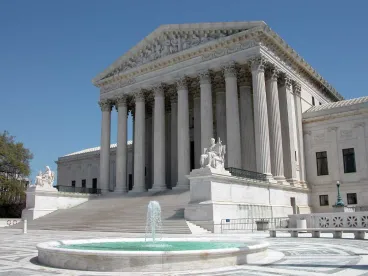On June 26, 2023, the Supreme Court of the United States agreed to hear a rare challenge under the Sixteenth Amendment and Tax Clauses to Section 965 of the tax code. In Moore v. United States, the justices will consider whether the one-time Section 965 transition tax violates the US Constitution as a “direct tax” that has not been apportioned among the states. The Court’s decision in Moore could potentially have far-reaching and major implications in many areas of tax.
IN DEPTH
BACKGROUND ON THE CASE AND SECTION 965
Section 965 deems the accumulated post-1986 deferred foreign income of specified foreign corporations, including controlled foreign corporations (CFCs), to be subpart F income and thus currently taxable to 10% US shareholders. Section 965 was enacted by the Tax Cuts and Jobs Act of 2017 (TCJA) as part of the transition from a deferral system (where US shareholders were not currently taxed on most earnings of foreign subsidiaries but were taxed on distributions from foreign subsidiaries) to a territorial system under which companies are eligible for a 100% dividends received deduction with respect to distributions of foreign earnings.
Moore concerns the tax liability of Charles and Kathleen Moore who, inspired by their friend’s mission to empower subsistence farmers in India, made a modest investment nearly two decades ago in a small social enterprise in Bangalore in exchange for approximately 11% of the stock of an Indian corporation. According to the record, the Indian corporation reinvested its earnings, the Moores never received any distributions on their investment and the Moores (under pre-2017 law) never incurred any tax liability on their investment. As a result of Section 965, however, the Moores were deemed to have earned income from their investment and were taxed accordingly.
For the Moores, that meant a $15,000 tax bill. Tax revenue by reason of Section 965 has been estimated to be in the hundreds of billions.
The Moores sued, arguing that by taxing them on gains to their investment that they never received, or “realized,” themselves as income, the government had imposed a direct tax, which the Constitution says must be apportioned among the states.
Recently, the US Court of Appeals for the Ninth Circuit upheld the tax, holding that there is no constitutional requirement that income taxed by the federal government be realized by the taxpayers. The Moores appealed to the Supreme Court, and on June 26, the Court agreed to hear the case next term.
THE CONSTITUTIONAL ISSUE IN MOORE
Moore involves the interplay of two provisions in the Constitution pertaining to taxation: the Tax Clauses and the Sixteenth Amendment.
Article I of the Constitution provides that Congress may institute “direct taxes”—i.e., taxes levied directly on persons and their property—only if the revenue from the tax is apportioned among the states according to population. (See U.S. Const. art. I, § 2, cl. 3; art. I § 9, cl. 4.) In other words, the amount of tax revenue collected from each state relative to the total revenue nationwide must be equivalent to the state’s share of the national population. In practice, the apportionment requirement makes it all but impossible for Congress to institute direct taxes.
A century later, when Congress attempted to institute a federal income tax, the Supreme Court held that a tax on income is a direct tax and must be apportioned. (See Pollock v. Farmers’ Loan and Trust Company, 157 U.S. 429 (1895) on rehearing 158 U.S. 601 (1895).) The public backlash was intense, as an income tax had become a popular reform in that era. Several years later, the nation adopted the Sixteenth Amendment, which allows Congress “to lay and collect tax on incomes, from whatever source derived, without apportionment.”
The question in Moore is whether Section 965 is a tax on income within the meaning of the Sixteenth Amendment or a direct non-income tax that must be apportioned among the states.
The Moores’ position is that the Sixteenth Amendment’s exemption from apportionment is limited to taxes on realized gains based in part on case law, such as Eisner v. Macomber and Glenshaw Glass, and the text of the Sixteenth Amendment, which contemplates that “income” will be “derived” from a source. The Moores’ brief indicates that the Ninth Circuit’s holding opens the door to new federal taxes on wealth and property. (For example, the Biden administration’s FY24 Green Book includes a proposed “25-percent minimum income tax” that would “require prepayment of taxes on unrealized capital gains.”)
The government’s position is that whether a taxpayer has realized income does not determine whether a tax is constitutional, and what constitutes a taxable gain is broadly construed. The government’s brief asserts that adopting the Moores’ position “would call into question the constitutionality of many other tax provisions that have long been on the books.”
POTENTIAL IMPLICATIONS
Section 965, a provision that resulted in hundreds of billions of dollars in tax liability for taxpayers and which was a core part (and revenue raiser) of the TCJA, is at issue. It’s unclear as to how the Supreme Court ultimately will rule in this case, and the range of possibilities includes a ruling in favor of the government, a narrow ruling in favor of the Moores (e.g., that Section 965 is unconstitutional for a minority shareholder lacking the ability to compel distribution of the relevant earnings), or a broad ruling that could have reverberations throughout the tax law by calling into question the constitutionality of many different income imputation or acceleration regimes. For instance, depending on the Court’s rationale, a decision in favor of the Moores could question the validity of subpart F (which has previously been held to be constitutional by lower courts but never considered by the Supreme Court) or the global intangible low-taxed income (GILTI) regime, even as applied to 100% controlling shareholders as opposed to minority shareholders. A broad ruling that invalidates all or some of Section 965, subpart F or GILTI could result in significant revenue loss to the US fisc, as well as adverse collateral consequences for taxpayers in certain situations, such as the treatment of prior distributions of foreign earnings that had been thought to be previously taxed earnings and profits and now could be viewed as distributions of untaxed earnings and profits, which may require the application of Section 245A rules in order for the distributions to be tax-free. The Court’s rationale could also preempt or support constitutionality challenges to wealth taxes that are being considered or call into question other portions of the tax code that are applying anti-deferral or mark-to-market principles.
TAKEAWAYS
Taxpayers should begin the process of considering the potential implications of the Supreme Court’s consideration of this case, including considering filing protective claims for refund for the transition tax or other taxes. Similar claims for refund may be warranted for corresponding state tax refunds. Taxpayers could also consider getting involved in amicus briefs to ensure that different perspectives are heard.






 />i
/>i

